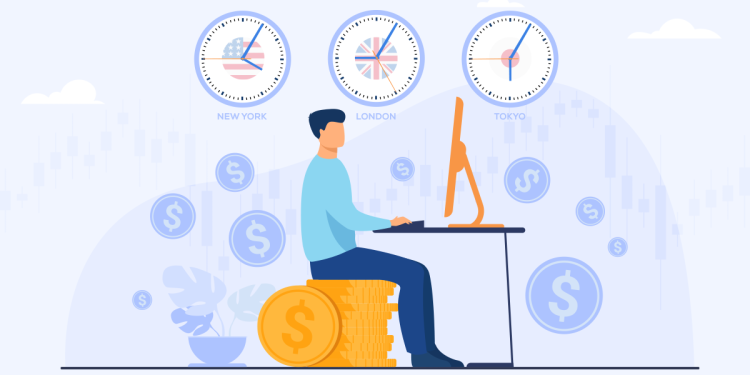Forex, also known as foreign exchange or FX, is the largest financial market in the world with over $5 trillion traded daily. The leverage currency trading allows individuals and institutions to exchange one currency for another in order to profit from fluctuations in exchange rates or for commercial purposes like international trade and tourism. This blog will provide you with an overview of forex currency trading and the key components you need to understand in order to get started.
What is Forex Trading?
Buying as well as selling currencies in pairs is what forex trading entails. The US dollar (USD) is most typically traded against other major foreign currencies You acquire a currency pair when you buy the base currency as well as sell the quote currency. When you purchase EUR/USD, for example, you are purchasing euros as well as selling US dollars. The idea is for the base currency’s value to climb relative to the quotation currency, allowing you to sell it at a higher price and lock in a profit.
The over-the-counter (OTC) forex market is decentralized and lacks a physical facility or central exchange. Instead, money transactions between two parties—typically big banks or other institutional investors—are carried out electronically. From Sunday evening until Friday afternoon, this international market is open around the clock in several time zones.
Choosing a Forex Trading System
From long-term position trading to short-term scalping, there are several ways to trade currencies. You must select a trading strategy as well as style that are compatible with your personality, and level of risk tolerance, as well as trading time. Listed below are a few popular Forex trading systems:
- Fundamental Analysis: Examining long-term patterns over the course of a few weeks or months by analyzing economic indices including interest rates, inflation, and GDP, as well as political events. substantial study is necessary.
- Technical analysis: Identifying entry and exit positions based on previous price activity over a range of timeframes, from daily to hourly charts, and using charts as well as patterns. More on the short term.
- Scalping: Scalping is the practice of trying to make money quickly from modest, frequent price movements. By quickly entering and leaving a large number of transactions throughout the day, traders attempt to profit from minute movements in currency pairings. It necessitates regular market monitoring and the capacity for swift transaction execution.
- Swing Trading: Swing trading includes recognizing medium-term price patterns on daily charts and maintaining open currency positions for 1 to 5 days. When the market has bounced between levels of support along with the resistance as well as is anticipated to move in that direction for the foreseeable future, traders hunt for chances.
- Day Trading:Opening as well as the closing all currency positions during the same trading session, which usually lasts from morning to afternoon, is known as day trading. Day traders search for intraday price patterns on daily charts as well as trade the short-term movements brought on by important news releases.
The best strategy for you will rely on your own objectives, and timetable, as well as level of risk tolerance. Before putting actual money at risk, it is preferable to start with the swing or position trading as well as test various trading methods on paper.
Opening a Forex Trading Account
The following thing to do is to create a Forex trading account once you’ve decided on a trading strategy. There are two primary categories of accounts:
- Standard Account: Allows you to trade currencies with leverage, usually between 2:1 to 30:1. Leverage amplifies both profits and losses, so use it carefully. Minimum deposit is typically $200-500.
- Micro Account: For beginner traders with lower risk tolerance. Offers smaller lot sizes and lower leverage, usually around 1:100. Minimum deposit is $5-50.
It’s important to research different Forex brokers and compare fees, platforms, regulation, education resources and customer support when choosing where to open your account. Reputable brokers are regulated by financial authorities in major markets.
Mastering Technical Analysis
Technical analysis is one of the most popular approaches for Forex traders. It involves using charts to identify patterns in price action and indicators like moving averages, Bollinger Bands and MACD to signal potential entry and exit points. Here are some key technical analysis concepts to understand:
- Trend Lines: Drawn between highs or lows to determine the overall direction of the market.
- Support and Resistance: Price levels where buyers or sellers tend to enter the market, halting the trend temporarily.
- Moving Averages: Used to identify short, medium and long term trends by smoothing out price data.
- Candlestick Patterns: Formations that indicate reversals or continuations.
- Indicators: Oscillators that measure overbought/oversold levels and momentum.
- Chart Timeframes: Combining analysis across daily, 4-hour and hourly charts for confirmation of signals.
It takes extensive practice to master technical analysis. Start by learning chart patterns, then practice drawing trend lines and identifying support/resistance on demo accounts.
Managing Risk with Proper Money Management
Successful risk management is essential for long-term forex trading success. Profits as well as the losses are increased in currency markets because of their high level of leverage. To prevent blowing your account as well as the limit drawdowns, it’s crucial to follow stringent money management guidelines. Among the essential ideas are:
- Never put more than 2% of your whole account balance at risk in a single deal.
- To swiftly limit losses if the trade turns against you, set stop losses beyond support and resistance.
- To lock up gains, take periodic partial profits on successful trades.
- To lessen the total risk of your portfolio, diversify your investments over several different currency pairings.
- Keep an eye on transactions as well as avoid getting greedy by taking winnings quickly rather than chasing movements.
- Before risking real money, try methods using demo accounts and virtual currency.
- Make sure that prospective gains constantly surpass stop loss levels to control your risk-reward ratio.
Conclusion
Forex trading may be a lucrative method to engage in the world’s financial markets with practice and self-discipline. However, it also entails hazards that need for prudent money management. Use stop losses at all times, and start with a practice account, as well as study technical analysis. You’ll be well on your way to mastering forex currency trading system with the appropriate approach along with the risk management.
















